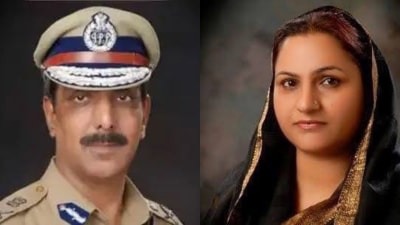The enigma of arrival
Over the last few weeks a range of luminaries have stampeded into the BJP and the party’s “untouchability” has come to a form...

Over the last few weeks a range of luminaries have stampeded into the BJP and the party’s “untouchability” has come to a formal end. Former cricketer Navjot Singh Sidhu, ageing superstars Jeetendra and Hema Malini, Assam’s cultural icon, Bhupen Hazarika, former secularist agitator Arif Mohammad Khan, and even retired ambassadors. And recently, another stately visitor processed into the BJP office. Nobel laureate Sir V.S. Naipaul not only visited the BJP office, he also held a press conference, was presented with angavastrams by Arun Jaitley and J.P Mathur and even made BJP-friendly statements about the antecedents of Sonia Gandhi.
Supporters of Naipaul insist that Sir Vidia is simply too lofty a figure to be constrained by smutty Indian party politics, that his visit to Ashok Road was only a courtesy call and he would have stopped off to meet the Congress too if only he had been invited. Perhaps. Perhaps the Naipaulean vision cannot and should not be harnessed to the Sangh parivar. Yet for the BJP, if not for Sir Vidia, Naipaul’s visit is an important landmark. For a potentially violent anti-intellectual political movement associated with tearing up film posters, destroying libraries and defacing paintings, even a courtesy call from an international literary figure provides the one attribute that Hindutva still does not possess: intellectual respectability. No wonder Arun Jaitley could not stop beaming.
Intellectual respectability has resided for decades with the Nehruvian elite, exemplified in the persona of people like of P.C. Mahalanobis, architect of the Second Plan, S. Nurul Hasan, education minister and associated closely with the Indian Council of Historical Research, M.S. Swaminathan and the Indian Council for Agricultural Research, the stylish Pupul Jayakar and the Indian Council for Cultural Relations, scientists like Vikram Sarabhai, industrialists like J.R.D. Tata, diplomats like V.K. Krishna Menon, key bureaucrats like B.K. Nehru. The Nehruvians may have been anglicised and socialist (though not always), yet they were incorrigibly inclusive. Above all, they were determined to refute Winston Churchill’s racist scorn that Indians by definition were lowly and degraded and India would break up as soon as it became independent.
No, Mr Churchill, the Nehruvians yelled, we’ll show you that India isnot a failed experiment! To prove it, they rolled up their sleeves and built great institutions with the word “Indian” or “Hindustan” emblazoned proudly in their titles, institutions that have endured to this day. The shallow hindutvavaadis don’t realise why cities like Hyderabad and Bangalore have emerged as IT centres and centres of New India. Precisely because the Nehruvian vision located public institutions there and thus created a professional, educated class which powered those cities to fortune. DRDO, HMT, HAL,NAL, ISRO and others were set up in Bangalore and other cities. The venerable V.K.R.V. Rao — founder of the Delhi School of Economics — built the Institute for Social and Economic Change in Bangalore. Not to mention the geographically dispersed IIMs and IITs, set up, let’s not forget, to provide managers for the Indian public sector and forge the scientific temper. In far-flung regions away from Delhi, Nehruvian frontiersmen slogged at their institutions and undoubtedly dominated them for decades. And the sangh parivar “intellectuals” were..er..where?
In cultural life, the Nehruvian vision dominated, too. Dilip Kumar, Ismat Chughtai, R.K. Narayanan, Rukmini Devi Arundale were heroes and heroines of Nehru’s India. And, until today, it’s not merely the ‘angrez log’ who oppose Hindutva. Indeed the most trenchant critique of the parivar comes from regional and Hindi writers, whether it is Prabhash Joshi (writer of the famous essay, ‘Yeh to Raghukul nahin’), or poets Namvar Singh and Ashok Vajpeyi, or novelists Mahasweta Devi and Krishna Sobti or playwrights Girish Karnad and Habib Tanveer. Others like Amitav Ghosh, M.F. Husain, Anjolie Ela Menon, Gen Next historians like Sanjay Subrahmanyam and Sunil Khilnani, analysts like Yogendra Yadav and Purushottam Aggarwal, have all spoken out against the crude tactics of the Hindu army. Indeed, how can any writer support a party whose cadres love burning books? How can any artist support a force that might rush into his exhibition and tear up his paintings?
Today, the BJP has everything. It has the votes, it has the alliances, it has the infotech, the medieval rath, slogans and it has created a mindless ‘hip’ younger generation which wears spaghetti straps and dances away in five-star hotels in public but mouths a regressive hate-filled conservatism in private. The BJP is blessed, above all, with a lameduck “foreign” opposition. But the only thing the BJP still doesn’t have are the intellectuals and the institution-builders. For, in pluralist India, you simply cannot build institutions unless you adopt the policy of inclusion: enduring national organisations can hardly be built on foundations of hatred.
No wonder Naipaul’s visit is an important milestone in the BJP’s search for legitimacy, to establish that it’s not a party of well-dressed bigots who, as soon as they come to power, revert to hard Hindutva despite all development promises. In MP, Uma Bharti has declared three towns as vegetarian, routinely diverts chief ministerial cavalcades for baths in the Narmada and is eagerly pushing gaushalas. All this in Bhopal, city of ‘Ganga-o-Jamuni tehzeeb’, of Jan Nisar Akhtar and Safia Akhtar (Javed Akhtar’s parents), B.V. Karanth and Kaif Bhopali, lyricist for Pakeezah!
The BJP has a complex. It has a complex that it still has not been able to win over the thinkers, artists and historians whom it vilifies as “pseudos” and “leftists”, without stopping to think that Sumit Sarkar, the “leftist” historian, may use Marxian tools of analysis in his history but has also written a paper entitled ‘The Katham Amrito of Ramakrishna Paramahansa’ which when delivered in Kolkata was applauded by an audience of bhikshus.
Today, Sonia Gandhi and her dynasty are preventing the growth of a substantial anti-Hindutva opposition and contributing directly to the BJP’s rise. Yet, for the BJP, political legitimacy as India’s rulers can’t only come from the electoral benefits of having the hopeless Sonia Gandhi as opposition leader. Legitimacy will come with the creation of an inclusive, civilised and cosmopolitan ruling culture that endures through the generations as successfully as the Nehruvian one has done.





- 01
- 02
- 03
- 04
- 05


























